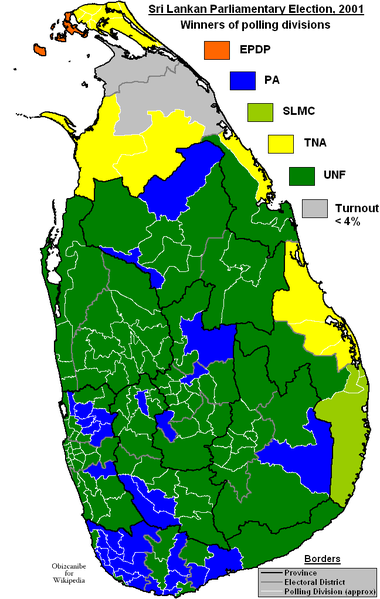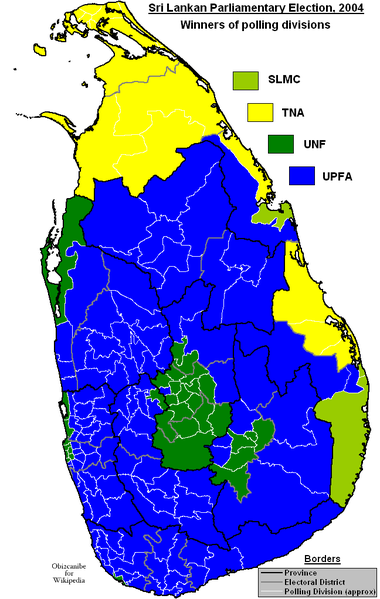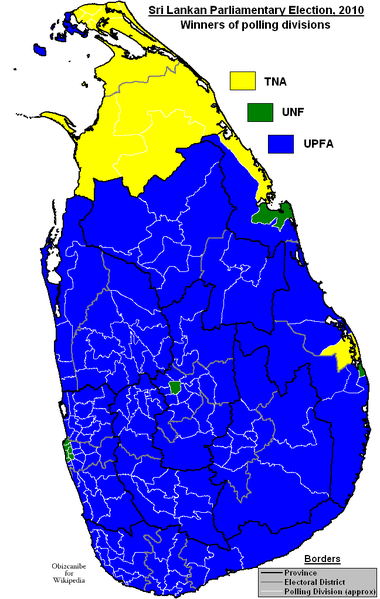
Ilankai Tamil Sangam
Association of Tamils of Sri Lanka in the USA
Published by Sangam.org
by Gogol G., Voices in Exile blog , May 26, 2012
|
Or putting it all together, compared to the original 4 million Tamils in 1981, by 2009, there were only 63.8% who were still in the island, alive, and not living sub-animal conditions inside barbed wire. Again, 63.8 % ! |
It should be obvious now that the political structure of SL is the root cause of the SL conflict and every facet that perpetuates the conflict: majoritaniarism via identity, language, religion; re-imagined historical narratives treating Mahavamsa like a historical text in the schools (even though its earliest details are fuzzy, grandiose and mythologise Sinhalese as ordained by Buddha, Tamils seen as enemies, and it betrays a lack of understanding of Tamil-Sinhalese origins and chronology), even smart Sinhalese today are taught that Tamils are interlopers and would be shocked at chronology and Tamil antiquityand how Sinhalese relates to Tamil; majority group dominance of govt majority community over-represented in legislature, courts judge based on Sinhalese-crafted laws/constitution, police is 95% Sinhalese, military is 99% Sinhalese and deployed solely internally against common wisdom or efficacy of its proper role, unfair practice of governance unfair laws (in the 1st year alone, enacted retroactive stripping of Tamil plantation worker citizenship), unfair implementation (even after Tamil made an official language, it is hardly used in practice, while monolingual Sinhalese judges, teachers, etc. are appointed to high posts in traditional Tamil areas), judicial rulings based on unfair laws/constitution created without Tamil participation, unjust violence committed by majority group (despite reasonable demands), starting with the first Sinhalese mob violence against Tamils in 1939, and continuing onwards, and it hasn't stopped yet; suppression of dissent against majoritarianism even aspects like the religion of the majority became politicised, and now that the Tamil Tigers were defeated in 2009, Sinhalese are finally realising that the "dissent" being silenced can be from anyone. History points us clearly to the fact that the structure operates as a "positive feedback loop", i.e. self-perpetuating and self-intensifying.
For such a simple idea, it's easy to get lost in the minutiae of the litany of supporting evidence. And even though it's a simple idea, even now, even among educated people in the Diaspora (even youth), the problem of SL's structure is parried with tangential details, or the issue is de-emphasised in favour of concern for the resulting symptoms.
Here, I just want to suggest another way to reason about why the structure is the root problem: basic math!
BASIC MATH OF SL'S GENOCIDE OF TAMILS
Before the SL govt masterminded the Black July pogrom in 1983 (and yes, the SL govt indeed masterminded Black July well in advance), there were 4 million Tamils in SL, mostly living in the traditional homelands in the Northeast. Since 1983, more than 1 million Tamils fled the island and now make up the Tamil Diaspora. In Black July alone (roughly a week long), at least 3000 Tamil civilians were killed. From 1983 to 2008, at least 65,000 Tamil civilians were killed. And in 2008-2009, at least 40,000 Tamil civilians were killed, while some people say the death tool in this period could be as high as 147,000. Before 2009, there were roughly 20,000+ Tamil soldiers of the LTTE who died, so perhaps that number is at least as high as 40,000 by now. So from that original number of 4 million Tamils in 1981, 25% of them fled to the Diaspora, leaving 3 million remaining. Of that 3 million, at least 108,000 Tamil civilians killed and 40,000 Tamil soldiers dead (of the 3 million, that's 3.6% + 1.3% = 4.9% killed). Out of the 2,852,000 surviving Tamils in the island, in 2009, 300,000 Tamils were put into internment camps like Menik Farm for more than a year. That means 10.5% of Tamils still alive in the Northeast were kept in internment camps in the Northeast in 2009. Or putting it all together, compared to the original 4 million Tamils in 1981, by 2009, there were only 63.8% who were still in the island, alive, and not living sub-animal conditions inside barbed wire. Again, 63.8 % !!!! Keep in mind that all of these numbers are underestimates of the suffering of Tamils perpetrated by the Sri Lankan government. History will be the ultimate judge of which & whether those actions are colonisation, war crimes, or genocide, and whether those camps are internment or concentration, but I'm obviously not going to wait to call a spade as a spade.
BASIC MATH OF SL'S POLITICAL STRUCTURE
| Tamil | Winning Singhalese | All Singhalese | |||||||
| year | % of NE Tamils in island (1981 census) | % of votes island-wide to TNA | # of bonus seats | % of seats in Parl. | % of Singhalese in island (1981 census) | % of votes island-wide to winning Sing.-coalition | # of bonus seats | % of seats in Parl. | % of seats in Parl for all Sing.-led parties/coalitions |
| 2001 | 12.71% | 3.89% | 1 | 6.7% | 73.95% | 45.62% | 13 | 48.4% | 89.8% |
| 2004 | 12.71% | 6.84% | 2 | 9.8% | 73.95% | 45.60% | 13 | 46.7% | 87.1% |
| 2010 | 12.71% | 2.90% | 1 | 6.2% | 73.95% | 60.33% | 17 | 64.0% | 93.8% |



DEALING WITH A RIGGED POLITICAL STRUCTURE
If the structure is rigged, and if that leads to conflict, and if the conflict has ruined SL's governance, democratic institutions, social fabric, and standard of living (yes, the structure is a self-defeating thing), then why does it persist? Well, the first answer is obvious: greed. Someone is benefiting -- the Singhalese politicians who claim power, and on a collective level, the Sinhalese vis-a-vis the minorities (i.e., Tamil-speaking peoples of the NE).
Let's say that you think, though, that given a somewhat decent Singalese politician, the structure can be changed for the benefit of all, and everyone can live happily ever after. Not so fast. See, people work based on incentives. In SL, incentives are given by the political equations that the structure creates. Unfortunately, instead of tackling the hard problems despite great risk, politicians will follow the path of least resistance, as indicated by the political equations. In SL's case, that means exterminate Tamils, steal their land and businesses, then repeat again on the Muslims, until you're left with a mono-ethnic Singhalese banana republic. This is nothing groundbreaking - it could be material for a chapter in another Freakonomics book. (That might be a hard sell for a book publisher since it's too soon to tell this story given that also involves discrimination, racism, war crimes, genocide, and geopolitics.)
So politicians are just rats in a rat race. They don't attempt tackling or hanging a bell on the tougher problem. Instead, they just do what it takes to get to the finish line. Those who don't know how to finish either get sidelined, sacked, or assassinated. Bandaranaike the 1st (SWRD Band., husband to Srimavo and father of CBK) promised & delivered Sinhala Only, but was assassinated by a Buddhist monk out of concern he wasn't catering enough to Buddhism. Wickremasinghe was elected on a "no more war" mandate in 2001 (after all, SL's economy contracted in the 2nd half of 2001 due to the LTTE's surgical, zero-civilian-wounded attack on the airbase and adjoining Katunayake airport). For entertaining the idea of federalism and the LTTE's skeleton framework of federalism via their ISGA proposal, CBK effectively crippled and sacked Wickremasinghe's govt in 2004. Wickremasinghe seemed to have learned his lesson: during his campaign in the presidential election in 2005, he hinted at taking credit for weakening Tigers, but that wasn't enough. So in the final 3 days of the campaign, he took credit more explicitly, and pandered to Sinhalese Buddhism more explicitly. It was too little, too late. And even now, he has been sidelined by dissidents in his own party multiple times since 2005 for not being "strong" enough. Clearly, none of these guys are principled, but the behaviour of average politicians acting within a structure is not a question of morality or immorality. It's a question of amorality: what do I need to do and say to get from point A to point B faster and better?
Now, a true statesmen is someone who can identify the true underlying problem (naturally a tougher nut to crack), identify the solution(s), and do the needful to solve the problem. Politicians are a dime a dozen, but true statesmen are a rare, genuine wealth to the people they serve. Statesmen are the ones who can find ways to make the radical changes from an outdated system to a new system that serves everyone's interests now and for the future. Statesmen are not just smart enough to determine the solutions, but can engage in the messaging campaign necessary to take the message to the masses. One good example in Canadian politics is the idea of multiculturalism to deal with a structural problem in a way that served long-term interests of everyone. The idea of "multiculturalism" is largely understood to be an inherent good and it sticks in the minds of most Canadians (even if they don't understand it, it doesn't impact them directly, or it conflicts with their closet prejudices). The messaging of the current Obama administration in the US shows signs of such savviness by describing the sunset of Bush tax cuts as the way to preserve govt services and close the deficit as "basic math". The idea of "basic math" should be hammered home until Nov. 2012, and it should also be applied to discussions on the health care act, etc., too.
It doesn't take a genius to see that the current structure of SL stacks the numbers in favour of the Singhalese against the Tamils. In addition to arguments based on common sense and patterns of history, it may also help to explain arguments for significant autonomy to the traditional Tamil-speaking homelands through the argument of basic math. Arguing for people to employ basic math is not being simplistic about the matter; rather, it is a simple explanation for a simply-expressible cause underpinning the SL conflict: the political structure of the island of Ceylon.
----------------------------------------------------------------------------------
Opinion: Re-emerging Cold War Most Visible in SL as NE Tamil-speaking People Suffer
VOICES IN EXILEhttp://voicesinexile.blogspot.com/VIEW MY COMPLETE PROFILE
© 1996-2025 Ilankai Tamil Sangam, USA, Inc.